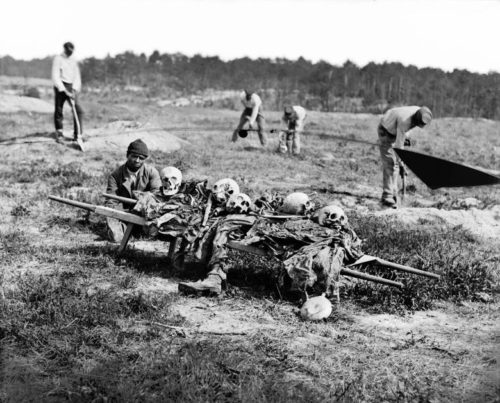
Yes. Yes he did.
And now for some American history to give much-needed perspective on the kind of information warfare tactics long used by white nationalists.
There have been many sad attempts over the last several decades to project the term “butcher”, notably deserved by the white supremacist and traitor General Lee, onto someone else instead. Who? His avowed enemy of course, U.S. General Grant.
Keep in mind that Grant was a vastly superior military tactician to Lee even by simple math. Commanding Union troops for 16 battles put Grant in the top ten list for Generals OF ALL TIME. Lee is so far down that list he wallows with a negative score!
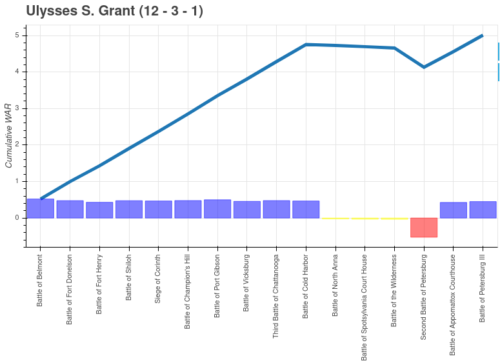
The argument/propaganda against Grant’s brilliance and success in battle tends to go like this: while Grant decisively defeated pro-slavery forces, even capturing multiple armies and routing them entirely with reduced bloodshed, too many people died when Grant pressed forward on battlefields in his mission to end war quickly.
Somehow Grant should have had fewer casualties yet more expediently won a war that Lee intentionally had been making more brutal. This is a load of nonsense, as historians easily point out.
Given the scope of his achievements in three theaters, Grant’s overall casualty numbers are amazingly low. Given the finality of his defeat in his single theater, Lee’s casualty figures are surprisingly high, and they show how he drained the entire Confederacy of its limited manpower. If Grant had fought less aggressively, the Union would not have won. If Lee had fought less aggressively, the Confederacy’s prospects for success would have been enhanced.
First, over the duration of battles Grant’s per capita losses were less than Lee’s. It’s pretty simple to see that fact. If Grant had been anything close to using Lee’s tactics, far more Americans would have been killed.
Brands’ biography “The Man Who Saved the Union” gives data to make this clear. Grant’s autobiography also firmly established him as an early modern strategist (building upon his experience as quartermaster) who fully understood why professionals study logistics and how efficiencies pay off.
So the facts are in already and Lee clearly stands worse on casualty rates and brute force attempts.
Second, think about the irony of the propaganda against Grant, the false projection of Lee’s atrocities, meant to denigrate the actual brilliant leader and victor of the whole war.
The pro-slavery militant states seceded and declared war, then high casualty rates caused by their own leadership tactics (expressly ordering the butchering of U.S. soldiers) were attempted to be blamed on… their sworn target of attack, the United States.
It’s easy to see why pro-slavery historians have for so long tried to project this “butcher” label onto the wrong man and away from those who had started a war to expand slavery Westward. Grant clearly had more quickly and decisively defeated Lee compared to anyone before him. The “heritage” revisionists hate Grant for that simple fact alone.
Who was the real butcher?
Think about the fact that Grant not only was a brilliant war-time tactician, he was the father of the civil rights movement after he ended war. He literally both stopped the pro-slavery Generals butchering Americans and then pivoted and worked on a foundation of civil rights to protect against the tribal southern militias (e.g. KKK); after emancipation and from a political role he again stopped the butchering (e.g. KKK).
Let’s look now at Chernow’s seminal new work because it often gets cited as the most definitive study yet. He seems very decisively to neutralize a lot of anti-Grant propaganda with rich first-person source material. It establishes clearly how Grant thought deeply both strategically and tactically how to end the war quickly and minimize suffering:
Start with how Grant is described as reflecting upon battles solemnly, highly concerned with the rate of casualties after doing everything he could to be mindful and transparent of the costs.
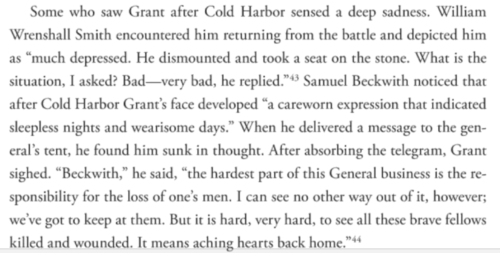
Conversely then we see pro-slavery Confederate General Lee intentionally delaying aid to wounded soldiers who lay exposed and dying on a battlefield. The traitorous Lee maintained a butcher’s mentality through the war, using inhumane tactics against non-whites as well as dehumanization of those who fought to protect the U.S. from its enemies.
To be clear here, as anyone literate in history should be able to say, Lee hated black Americans:
White supremacy was one of Lee’s most fundamental convictions.
And Lee wasn’t just awful as a white supremacist, he was the most awful and led some of the worst atrocities in American history.
He had his armies invade and capture civilians in order to… enslave Americans and turn them into property of foreigners.
During his invasion of Pennsylvania, Lee’s Army of Northern Virginia enslaved… Americans and brought them back to the South as property. Pryor writes that “evidence links virtually every infantry and cavalry unit in Lee’s army” to the abduction of… Americans, “with the activity under the supervision of senior officers.” Soldiers under Lee’s command at the Battle of the Crater in 1864 massacred black Union soldiers who tried to surrender.
Think about that for a long minute. Anyone honoring Lee is celebrating Americans captured by foreign invasion and made into slaves. Who really wants a school or a street in America named for a man who invaded to enslave Americans?
Chernow tells us also how Lee thought bureaucratic delays to aid would help him maximize suffering of Americans, very overtly butchering them and leaving them to die in the worst conditions because he was “intent on teaching a lesson to Grant”.

I have yet to find regrets or similar thoughts in Lee’s writings that achieve the moral high ground of Grant. Instead I find repeated references to this “teaching a lesson” mantra, such that butchering Americans was a pro-slavery political terror tactic.
Lee’s leadership not only never managed to capture any forces (frequently murdering prisoners of war instead). His peers (i.e. General Nathan Bedford Forrest, Lee’s counterpart in the Western Theater) were infamous instead for cruelly deceptive and inhumane tactics during war and later starting the KKK to spread terror campaigns nationally after the end of official hostilities (i.e. to this day Forrest, Arkansas is named for the pro-slavery anti-American terrorist).
Let’s look next at General Forrest, known among pro-slavery groups as “The Wizard of the Saddle” (later named first “Grand Wizard” of the KKK). During war his reputation was built around things like escaping from battle by grabbing a “small” U.S. soldier as hostage and using him as a human shield.
His specialty was sabotaging U.S. supplies and communications, using deception tactics and deceit in what he described as “a heap of fun and to kill some Yankees”. Most infamously General Forrest drove over 2,000 pro-slavery forces towards U.S. soldiers in Fort Pillow on April 16, 1864, he twice waved a “flag of truce” at them.
Here two soldiers recall what they witnessed after Forrest stormed the fort and literally butchered hundreds of U.S. soldiers who were surrendering:
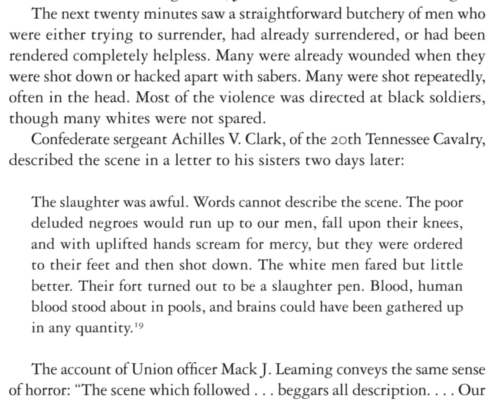
by S. C. Gwynne, p 19
General Chalmers (Mississippi cavalry who later became known for using violent voter suppression to win a seat in Federal government) reportedly bragged about this event in words similar to General Lee that a butchering at Fort Pillow was intentional and to teach “the mongrel garrison” a lesson.
Harper’s Weekly described the situation in their 1864 news report as murdering women, children and then mutilating the dead:
“Both white and black were bayoneted, shot, or sabred; even dead bodies were horribly mutilated, and children of seven and eight years, and several negro women killed in cold blood. Soldiers unable to speak from wounds were shot dead, and their bodies rolled down the banks into the river. The dead and wounded negroes were piled in heaps and burned, and several citizens, who had joined our forces for protection, were killed or wounded. Out of the garrison of six hundred only two hundred remained alive. Three hundred of those massacred were negroes; five were buried alive.”
General Forrest himself wrote, like Lee and Chalmers said above, that he was intent on being a butcher to send a specific message to the U.S. about white supremacy.
It is hoped that these facts will demonstrate to the Northern people that the Negro soldier cannot cope with Southerners
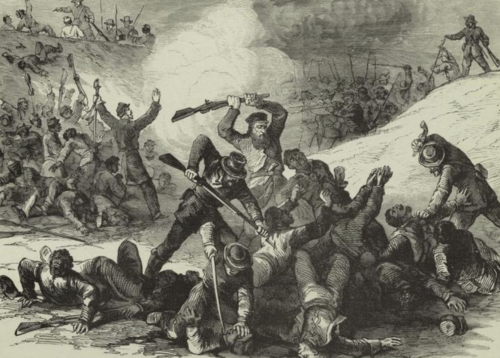
In case it isn’t clear why we’ve slid into discussion of Generals of the pro-slavery rebellion beyond General Lee himself. The massacre at Fort Pillow was clearly widely reported and of much discussion in early 1864.
Widely reported. Clearly about being a butcher.
This run-up of events needs to be extremely clear because in July 1864 it was pro-slavery forces directly under General Lee who butchered Black U.S. soldiers trying to surrender and again afterwards as prisoners. Here are the recollections from the Battle of the Crater in Virginia:

Who was the real butcher?
Those who ignore or revise history to denigrate Grant are actually hiding the pro-slavery mentality of excessive cruelty in battle and after. People have unfairly and intentionally attacked Grant’s reputation by projecting the crimes of Lee and his men for their own political gain.
Once people admit Grant is the one who stopped these butchers and their massacres and inherent inhumanity of pro-slavery forces, it could open the door to some other very relevant facts about white nationalists and why they continue to be threats to the U.S. even today.
Grant emancipated his slave before war, then rose through ranks to win the war, then started a civil rights movement and wrote a memoir that admitted faults and fears for a lasting peace to be achieved.
Lee threw away his citizenship so he could start a war to expand the enslavement of humans, repeatedly left thousands of American soldiers dying in great pain to politicize his unjust cause, and murdered his prisoners of war, leaving a legacy of white supremacists who to this day try to defame and denigrate real American heroes.
Who was the real butcher?
Greenwald provides further analysis of how Grant was brilliant and determined with his strategy, which meant he accepted criticism, while Lee romanticized blunders and infamously would shine his boots sooner than check the welfare of his troops.
Approximately a year earlier, in July 1863, Lee launched a massive assault against Union forces near a small hamlet in southeastern Pennsylvania. That assault, labeled “Pickett’s Charge,” cost Lee’s forces approximately 6,000 men. Yet, that charge has been romanticized and remembered more favorably, and is part of the lore of the fallen Confederacy. Meanwhile, Grant’s assault gave him the moniker “The Butcher.”
Delving even further, Grant had also launched a massive assault against a protruding salient at Spotsylvania Court House. That one broke the Confederate line, ushered in 18 hours of fierce hand-to-hand combat and almost resulted in breaking Lee’s army in half. Grant is not remembered as a butcher for that action.
A “butcher” does not have strategic vision and would continue to batter his head against an entrenched enemy, continue to throw men recklessly against his position. Grant, however, did have a vision: destroy Lee’s army. And if Cold Harbor did not offer that opportunity, then another place of his choosing would.
Grant was no butcher. Chernow closes the case on this, with Grant himself explaining why the title could never fit:

Now if we could just get journalists to stop repeating the “butcher” propaganda, and instead fairly depict Grant for the humanitarian leader and brilliant military mind he really was who earned global respect for his values and achievements.
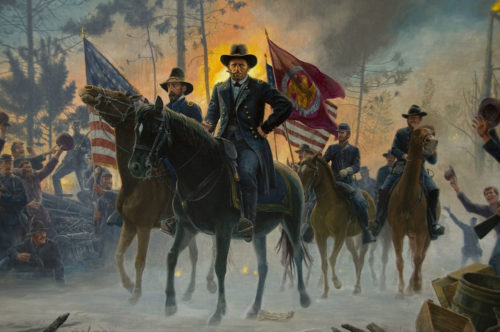
This article sheds light on an important aspect often overlooked. General Lee did refuse aid to wounded Federals by claiming he cared about a potential risk that might or might not happen, while not caring about actual suffering and loss of life he caused right then and there. Grant’s intention to propose a truce and facilitate the care of presently wounded soldiers lying without aid (by comparison) can be seen as a humanitarian gesture, reflecting concern for the welfare of soldiers on both sides. Grant was aware of the human cost of the war and likely sought to mitigate unnecessary suffering, whereas Lee was known to believe in maximizing suffering as a terror tactic.
After the domestic terrorist group Ku Klux Klan was formed in 1865 it immediately was known as a secretive and violent organization to oppose rights and freedoms granted to Americans during the Reconstruction era. The Klan used horrific acts of terrorism, including torture, to suppress and control Blacks as well as anyone who fought for American freedoms. It was Forrest himself who played a very significant role in shaping the structure and activities in its early days as the first ever “Grand Wizard” in 1867. His role at Fort Pillow was simply foreshadowing of his later domestic terrorism.
The mistreatment and killing of Black American soldiers during the Battle of the Crater thus highlights an underlying racial hatred that defined the Confederacy and explaining the many atrocities they orchestrated.
Grant’s military leadership during the Civil War is widely regarded as effective and especially successful (e.g. capturing multiple enemy armies multiple times), so very unlike Lee’s notoriously grinding bloody failures. Despite facing significant challenges, Grant repeatedly adapted his strategies and tactics, leading to ultimate victory of the Union. Grant’s approach during the Overland Campaign and other battles demonstrated his resilience, which blows up any claims of victory by the Confederates at that point. While the Battle of Cold Harbor resulted in heavy casualties for the Union, Grant shifted past it to the southeast, making it just a small part of his larger tactical plan. In that sense Cold Harbor was barely registered strategically and perhaps shouldn’t even be factored separately within a campaign.
All that is to say thank you. I find much merit in your claims, with the perspectives and evidence you bring forward, and I applaud you for delivering fresh insights into a community where some still like to dress up their racism/hatred as “perspective”.
I deeply value your character and your courage in confronting the challenging aspects of history, especially when others seek to perpetuate falsehoods and propaganda. Your blog post resonated with me so much that I couldn’t resist sharing it with some of the old racist historians I’m acquainted with, just to witness their discomfort as their faces flush and steam seems to rise from their ears. Some points I’ve learned from your retelling
1) Grant’s portrayal as a “butcher” was a tool of propaganda wielded by disgruntled factions during Reconstruction and its aftermath. This portrayal, though false and not universally embraced, was championed by politically motivated critics with their own agendas. Grant’s rise to the presidency and his Reconstruction policies irked those still smarting from their defeat on the battlefield. These detractors aimed to undermine Grant’s authority and sully his reputation by falsely painting him as a failed military leader, despite ample evidence to the contrary. Their deception lay in twisting admiration for Grant’s unwavering pursuit of victory and his readiness to engage the enemy, which actually aimed to minimize casualties, into a supposed acceptance of needless loss of life to achieve objectives.
2) General Grant came to regret his decision to order the attacks at Cold Harbor, acknowledging it as the sole instance during the war where he felt he had erred in such a manner. He famously reflected on this, recognizing the grave mistake in launching the assault. Serious historians now portray Cold Harbor not solely as a decisive victory or defeat, but rather as a costly engagement within a wider campaign. This characterization takes into account an absence of territorial gains or strategic advancements.
3) Grant was celebrated for brilliance in preserving life, such as Vicksburg where he incurred under 10,000 casualties while inflicting 4X on the enemy (over 40,000). On the whole, Lee was rash in attack or stuck in trenches, clearly taking more casualties than Grant’s “thoughtful warrior” strategic maneuvers. https://www.clevelandcivilwarroundtable.com/why-grant-won-and-lee-lost/
Historians seem pretty clear that the butcher “Lee’s 20.2 percent killed and wounded rate was the highest among the major Confederate generals”. https://www.historyonthenet.com/civil-war-casualties-lees-battles